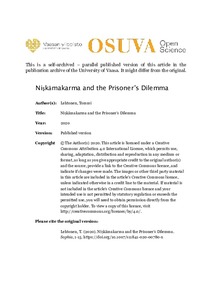Niṣkāmakarma and the Prisoner’s Dilemma
Lehtonen, Tommi (2020-07-14)
Lehtonen, Tommi
Springer
14.07.2020
Julkaisun pysyvä osoite on
https://urn.fi/URN:NBN:fi-fe202101121669
https://urn.fi/URN:NBN:fi-fe202101121669
Kuvaus
vertaisarvioitu
© The Author(s) 2020. This article is licensed under a Creative Commons Attribution 4.0 International License, which permits use, sharing, adaptation, distribution and reproduction in any medium or format, as long as you give appropriate credit to the original author(s) and the source, provide a link to the Creative Commons licence, and indicate if changes were made. The images or other third party material in this article are included in the article's Creative Commons licence, unless indicated otherwise in a credit line to the material. If material is not included in the article's Creative Commons licence and your intended use is not permitted by statutory regulation or exceeds the permitted use, you will need to obtain permission directly from the copyright holder. To view a copy of this licence, visit http://creativecommons.org/licenses/by/4.0/.
© The Author(s) 2020. This article is licensed under a Creative Commons Attribution 4.0 International License, which permits use, sharing, adaptation, distribution and reproduction in any medium or format, as long as you give appropriate credit to the original author(s) and the source, provide a link to the Creative Commons licence, and indicate if changes were made. The images or other third party material in this article are included in the article's Creative Commons licence, unless indicated otherwise in a credit line to the material. If material is not included in the article's Creative Commons licence and your intended use is not permitted by statutory regulation or exceeds the permitted use, you will need to obtain permission directly from the copyright holder. To view a copy of this licence, visit http://creativecommons.org/licenses/by/4.0/.
Tiivistelmä
The Bhagavadgītā, part of the sixth book of the Hindu epic The Mahābhārata, offers a practical approach to mokṣa, or liberation, and freedom from saṃsāra, or the cycle of death and rebirth. According to the approach, known as karmayoga (‘the yoga of action’), salvation results from attention to duty and the recognition of past acts that inform the present and will direct the future. In the Bhagavadgītā, Kṛṣṇa advocates selfless action as the ideal path to realizing the truth about oneself as well as the ultimate reality. Kṛṣṇa proclaims that humans have rights only to actions and not to their results, whether good or bad (2.47). Therefore, humans should not desire any results whatsoever. The prisoner’s dilemma is a fictional story that shows why individuals who seek only their personal benefit meet worse outcomes than those possible by cooperating with others. The dilemma provides an effective, albeit often overlooked, method for studying the Hindu principle of niṣkāmakarma (‘desireless action’) that is arguably the central teaching of the Bhagavadgītā. In the context of the prisoner’s dilemma, a prisoner who wants to uphold niṣkāmakarma may choose one of two decision-making strategies: to be indifferent and leave the decision to chance or to either pursue the common good or the other person’s benefit instead of his or her own. Assuming that followers of niṣkāmakarma can be goal-oriented, the second strategy is more appropriate than the first, as long as one pursues unselfish goals and remains both indifferent and uncommitted to personal benefit.
Kokoelmat
- Artikkelit [2621]
